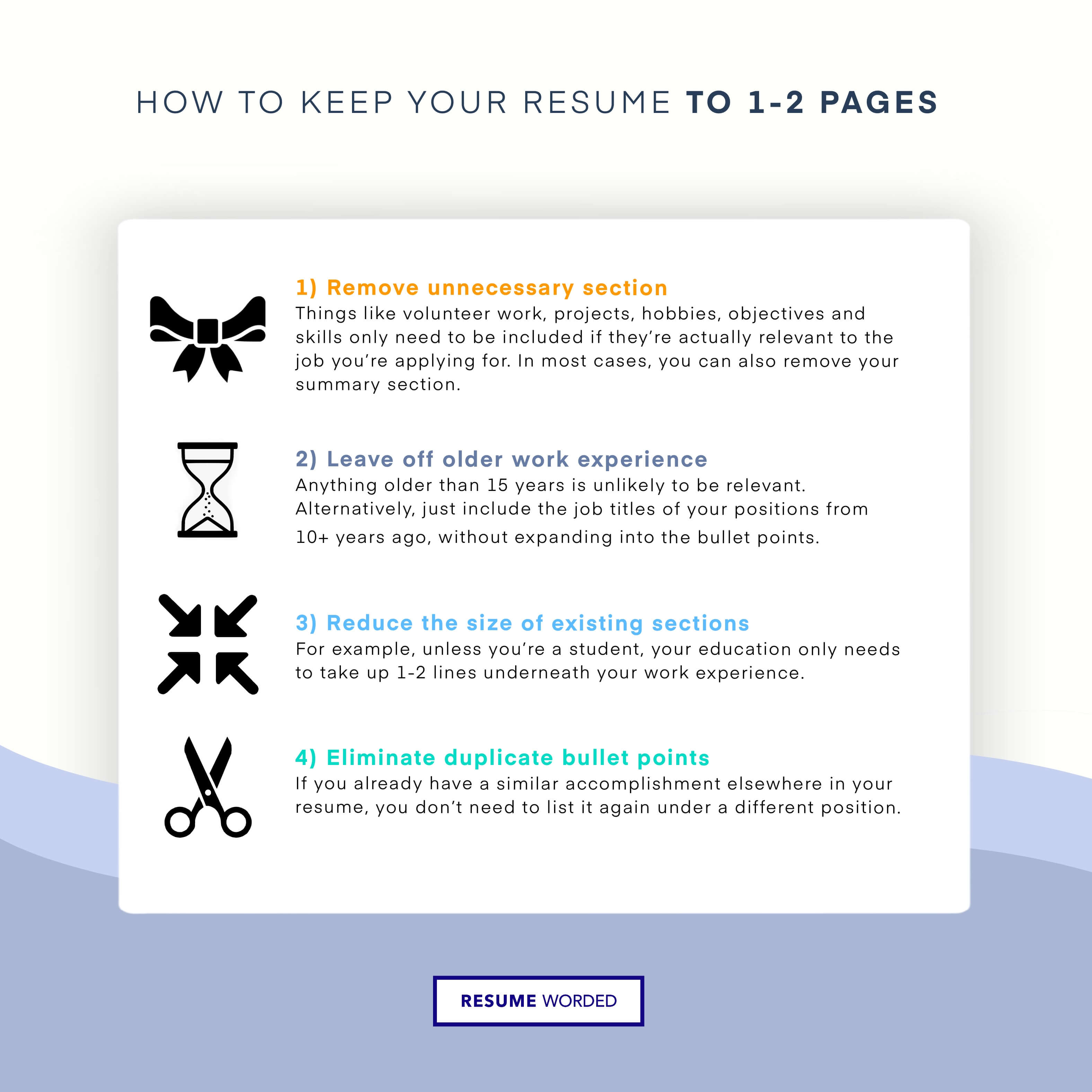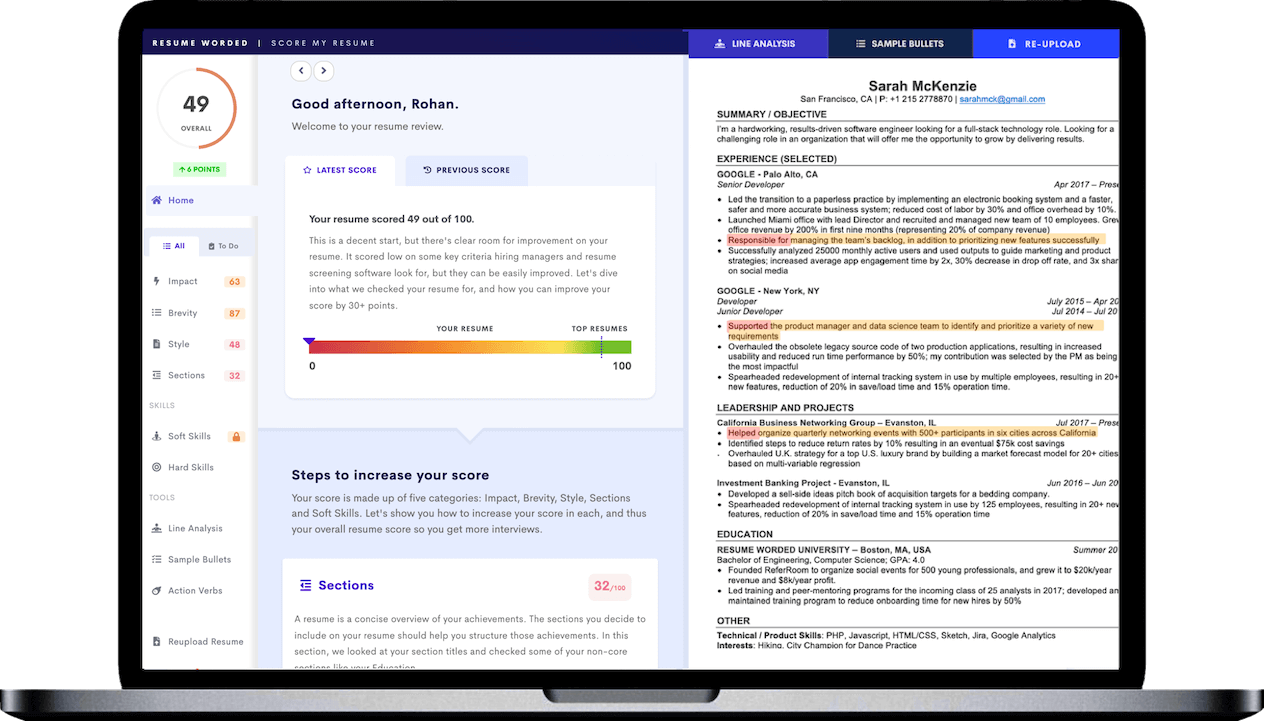So, you’re facing the challenge of creating a high-performing resume that showcases your essential skills but still fits onto one page. You don’t want to omit anything relevant, but how do you fit everything into one page without cutting important details?
To condense your resume to one page, focus on recent, relevant experience and remove anything not directly related to the application. You can also reduce your margins, merge related sections, and eliminate any duplicate information.
In this article, we’ll discuss why it's preferable to write a one-page resume, how to choose what to cut and what to include, and how to organize your resume to maximize readability and maintain a professional look.
Do you really need a one-page resume?
The short answer is yes and no. While it's not wrong to have a two-page resume, modern recruiters only spend an average of 7 seconds reviewing an application. With a two-page resume, a recruiter will spend less time reading each page, so it’s better to write one great page than two mediocre ones.
But surely it's better to include more information than less? Actually, no. The more you give a recruiter to read, the harder it is for them to pick out the information they want. While you might be tempted to include everything you've ever accomplished, it's far more useful to determine what a recruiter is looking for and showcase these skills upfront.
For most applications, a one-page resume is best, especially for entry-level positions or students. Only consider a two-page resume if you’re a senior professional with extensive relevant experience. Never make your resume three or more pages; It just won't be read.
If you're wondering whether your one-page resume effectively showcases all relevant experience and skills or if it should extend to two pages, upload it to the tool below for tailored insights on optimizing length and content.
How to make your resume one page
Knowing how to make your resume shorter is as much about knowing what to cut as what to include. The key is to be concise and direct, and only include your most impressive achievements. You might think you can't fit your resume on one page now, but even the longest resume can be trimmed down with a little targeted editing.
Tailor your resume to each application
The number 1 rule for fitting your resume onto one page is to tailor your experience to each application by only including information directly relevant to the job you're applying for. This means evaluating everything on your resume and only selecting roles and accomplishments that showcase the specific skills the new position is looking for.
For help targeting your resume, use our Targeted Resume tool to scan your resume for relevant keywords and receive personalized feedback on areas that can be improved.
Reduce margins and font size
You can reduce your page margins to 0.5 inches and font to 11 or 10 points to give yourself a little more room when trying to fit everything onto one page. But don't use a font smaller than 10, or margins less than 0.5, as this will make your resume cramped, harder to read, and overall less professional.
Remove duplicate information
When describing work experience, remove redundancy by combining statements and bullet points that discuss similar points. This will help you reduce unused space while also making strong, concise statements.
For example, the two bullet points below both discuss project management skills and describe similar roles and responsibilities:
- Led a cross-functional team in project planning, scheduling, and execution.
- Managed project budgets and ensured financial goals were met.
To reduce space, combine these two points into one sentence:
- Spearheaded cross-functional project teams, overseeing planning, scheduling, and budget management to consistently meet financial goals.
Cut irrelevant sections
Remove outdated resume sections that don't directly add to your application. Resume sections to consider cutting include:
- Objective statement: Replace your objective statement with a targetted resume summary, or simply remove it altogether. Modern recruiters are more interested in what you can bring to the table than what you're looking for in a position.
- References: Employers will ask for references when it's relevant and don't expect them to be included on your resume.
- Hobbies and interests: This section is often irrelevant to your application and can be cut to maintain clarity and relevance. Replace hobbies with skills that explain your abilities rather than your interests.
- High school information: If you have completed further/higher education, your high school details are generally no longer relevant and can be removed entirely.
- Education details: If you're a mid to senior-level professional with enough relevant work experience, reduce your education section to only your most recent accomplishments and degree.
- Volunteering: Though helpful for entry-level candidates, if you have enough paid experience for your application, remove any volunteering work and focus on paid roles.
Prioritize your most recent experience
Remember, you don't need to include every job on your resume, especially entry-level and short-term positions. Prioritize your most recent experience and focus on jobs that showcase relevant skills and quantifiable achievements. Remove any experience, education, and qualifications over ten years old unless it's specifically relevant to your application.
Make the most of each line
While you don't want to cram your resume so full of text it becomes hard to read, you can use some specific techniques to save space where it counts.
For example, when creating your resume header, instead of listing your address, phone number, and contact information on separate lines, combine all this information into one line, separated by dashes (-), dots (∙), or vertical bars (|). This creates a professional-looking header that reduces wasted space at the top of your resume, as shown in the example below.
You can save space by using a semicolon (;) to separate information on the same line. This is especially helpful in your education and qualifications sections, as shown below.
You can also use a semicolon to separate different subsections within your Skills or Additional Information sections, such as varying skill proficiency levels, as shown below.
Combine similar sections
If you have multiple sections to your resume that include a small amount of relevant information, consider combining your headings to make a more compact and streamlined document.
Work experience, volunteering, and professional projects can be combined into an "Experience" section to showcase all your relevant work experience, and education, certificates, and qualifications can be combined under one "Education" section.
Use an "Additional Information" section
"Additional Information" is a helpful section to highlight extra information relevant to your application that doesn't fit into other standard resume categories. Combining this extra information under one heading helps reduce space taken up by section headings and improves the readability of your resume.
Additional information should be listed at the bottom of your resume, and can include:
- Language skills
- Technical skills (if not including a specific skills section)
- Certificates, qualifications, and additional training
- Awards and achievements
- Volunteering or unpaid experience
- Publications
- Personal or professional projects
- Interests and hobbies
One-page resume examples
Here are some examples of optimized one-page resumes for entry-level and mid-level applicants. For more examples, head to our Resume Worded template library to browse and download various professional resume templates.
Here is an example of an entry-level one-page resume:
And here is an example of a senior-level one-page resume:










